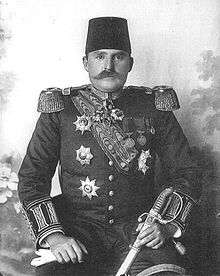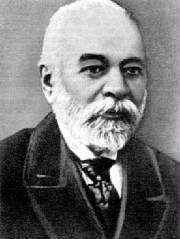Republic of Central Albania
| Republic of Central Albania Republika e Shqipërisë së Mesme | |||||||||
|---|---|---|---|---|---|---|---|---|---|
| 1913–1914 | |||||||||
 Flag | |||||||||
| Status | Former unrecognized country | ||||||||
| Capital | Durrës | ||||||||
| Common languages | Albanian | ||||||||
| Government | Republic | ||||||||
| President | |||||||||
| Historical era | After Balkan Wars and prior establishing Principality of Albania | ||||||||
• Established | October 16 1913 | ||||||||
| March 7 1914 | |||||||||
| |||||||||
The Republic of Central Albania (Albanian: Republika e Shqipërisë së Mesme) was a short-lived unrecognised state established on October 16, 1913 with its administrative centre in Durrës, today in Albania.[1]
History
The Republic of Central Albania was established by Essad Pasha Toptani[2] and ended when Wilhelm of Wied, prince of Principality of Albania, took control over the country upon his arrival in Albania on March 7, 1914. The territory of the state was bounded by the river Mat in the North and the Shkumbin in the South.[3] There are sources that connect the end of the Republic of Central Albania with the date of February 1, 1914, when an Albanian delegation led by Essad Pasha Toptani offered the Albanian throne to Wilhelm of Wied.[4] The flag of the Republic of Central Albania was red with white star in lower right part.[5]
The Republic of Central Albania issued its own post stamps.[6] Faik Konitza initially gave his support to the government of Essad Pasha.[7]
Essad Pasha Toptani

The most important role in establishing the Republic of Central Albania had Essad Pasha Toptani. During the First Balkan War, he became famous for his resistance during the Siege of Scutari. He was a member of the Toptani family, one of many families that were rich feudal Muslim landowners with privileged status during Ottoman rule. These Muslim landowners, together with Muslim priests, were afraid of losing their privileged status after the signing of the London Peace Treaty and the decision of the Great Powers about the future status of the territory which today belongs to Albania.
Support from the Kingdom of Serbia
The Kingdom of Serbia agreed to support Essad Pasha's government financially, and even with military force if needed. In exchange, Essad Pasha agreed to neutralize a large group of about 20,000 kachaks from Kosovo and Macedonia.[8] They were led by Isa Boletini and supported by Ismail Qemali and his Provisional Government of Albania. Essad Pasha agreed to help the Kingdom of Serbia acquire part of the coastal areas north of Black Drin.[9]
Relations with the Ottoman Empire
Pro-Ottoman Muslim landowners and priests supported Essad Pasha Toptani, who remained loyal to the Ottoman Empire during the First World War and maintained close contacts with the government in Istanbul. Young Turks from Istanbul were still hoping to restore Ottoman suzerainty over Albania and sent agents to Albania.[10] Those activities resulted in an (unsuccessful) attempt to declare Ahmed İzzet Pasha, then minister of defence of the Ottoman Empire, first prince of Principality of Albania. Ahmed İzzet Pasha was to prevent those landowners from achieving privileged status with the help of several hundred Ottoman soldiers sent to Albania. They were all arrested by Dutch gendarmerie on January 8, 1914, when they tried to disembark in Albania. The incident was officially denied by the government in Istanbul.
Izzet Pasha sent major Beqir Grebenali, another ethnic Albanian, to be one of his chief representatives in Albania. The Provisional Government of Albania under control of Ismail Qemali captured and executed major Beqir Grebenali. Such provocative and damaging display of independence of Qemali's government angered Great Powers and International Commission of Control forced Qemali to step aside and leave Albania.[11]
Rivalry with Qemali's Provisional government of Albania

While Essad Pasha Toptani established the Republic of Central Albania, there was another rival government in Vlore — the Provisional Government of Albania — led by Ismail Qemali[12] that wished to control the territory of the Republic of Central Albania. This government was established by a group of Albanians led by Ismail Qemali and gathered from four Ottoman vilayets. During the negotiations between Albanian rebels and negotiators from the Ottoman Empire in 1912, the parties had agreed to merge the four vilayets of Kosovo, Scutari, Monastir and Janina into one, Albanian vilayet. Since the First Balkan War started before this agreement was confirmed in the assembly of the Ottoman Empire, this united Albanian vilayet remained officially unrecognized. Its independence was declared on November 28, 1912 by a group of Albanians that Qemali had gathered from all four Ottoman vilayets together with four men, Albanians of Romania. Austria and Italy supported the intentions of Ismai Qemali and his government to create a state whose territory would span all areas populated by Albanians, including Kosovo, parts of Montenegro, Macedonia and Greece.[13]
In his work, Memorandum on Albania, Essad Pasha Toptani denied that Qemali's government was legitimate, writing that it was "the personal creation of a number of men."[14]
Aftermath
By establishing the Republic of Central Albania, Essad Pasha Toptani isolated supporters of Ismail Qemali and his Provisional Government of Albania from the northern part of Albania mainly populated with Catholic population. These Catholics were reluctant to submit to any of the two national governments, just as they were reluctant to surrender to the Porte.[15] Thus, after the Balkan Wars and before prince Wilhelm of Wied took control of the newly established Principality of Albania on March 7, 1914, Albania was divided into three parts. One part north of River the Mat was under the control of Catholics, the central part was territory held by the Republic of Central Albania and under control of government led by Essad Pasha Toptani, while the third part, south of the Shkumbin river, was under the control of the Provisional Government of Albania led by Ismail Qemali who declared independence of Albanian vilayet.
References
- ↑ Elsie, Robert. "Introduction to Memorandum on Albania, written by Robert Elsie". Switzerland: Web site of Robert Elsie, specialist on Albanian studies. Archived from the original on 17 July 2011. Retrieved January 8, 2011.
On 16 October 1913, ... Toptani set up a rival government based in Durrës, called the Republic of Central Albania.
- ↑ Jacques, Edwin E. The Albanians: an ethnic history from prehistoric times to the present. United States of America: McFarland. p. 344. ISBN 0-89950-932-0. Retrieved January 7, 2011.
he set up a rival government in Durrës which he called the Central Albania Republic
- ↑ Jacques, Edwin E. The Albanians: an ethnic history from prehistoric times to the present. United States of America: McFarland. p. 344. ISBN 0-89950-932-0. Retrieved January 7, 2011.
Its limited territory was bounded with Mat River to the north and Shkumbin River on the south
- ↑ Elsie, Robert. "Introduction to Memorandum on Albania, written by Robert Elsie". Switzerland: Web site of Robert Elsie, specialist on Albanian studies. Archived from the original on 2011-07-17. Retrieved January 8, 2011.
He reluctantly stepped down when forced to by the Great Powers on 1 February 1914, being given as a consolation the right to lead the Albanian delegation which travelled to Germany to offer the Albanian throne to Prince Wilhelm zu Wied.
- ↑ Cahoon, Ben (2000). "Albania". World Statesmen web site. Retrieved January 8, 2011.
- ↑ "Stamp Atlas - Albania". Sandafayre. Archived from the original on January 19, 2011. Retrieved January 19, 2011.
Essad Pasha set up his own regime and issued stamps for central Albania.
- ↑ Elsie, Robert (January 2006). Albanian literature: a short history. I. B.Tauris & Company, Limited. p. 106. ISBN 1-84511-031-5.
had initially given his support to the government of Essad Pasha Toptani
- ↑ Bataković, Dušan (1992). "Albanian Incursions into Serbia". In Ivan Čolović. The Kosovo Chronicles. Belgrade: Knjižara Plato. ISBN 86-447-0006-5. Retrieved January 8, 2011.
around 20,000 ethnic Albanians who fled Old Serbia and Macedonia found themselves on Albanian soil, while their leaders Hasan Pristina and Isa Boljetinac sat in the government at Valona. Austro-Hungarian and Italian emissaries and agents, mostly the clergy and teachers, suppressed Essad Pasha's influence and appealed to the ethnic Albanians to rise against the Serbs
- ↑ Vickers, Miranda (2006) [1995]. The Albanians: a modern history. London: I.B. Taurus. p. 82. ISBN 1-86064-541-0. Retrieved January 8, 2011.
Serbia had come to an understanding with Essad. ...Essad Pasha will be sent money, military plan calls for the complete annihilation ..... of Ismail Kemal, Isa Boletini and their friends,.... to undertake boundary rectification, in accordance with Serbia's wishes, up to the Black Drin.
- ↑ Vickers, Miranda (2006) [1995]. The Albanians: a modern history. London: I.B. Taurus. p. 82. ISBN 1-86064-541-0. Retrieved January 8, 2011.
The Young Turks ... still had hopes for restoring Ottoman suzerainty over Albania. They therefore sent agents to encourage insurrection...
- ↑ Vickers, Miranda (1999). The Albanians: a modern history. I.B.Tauris. p. 82. ISBN 978-1-86064-541-9.
plot was discovered by Ismail Kemal's agents; one of the Porte's chief representatives, Major Beqir Grebnali... executed
- ↑ Toptani, Essad Pasha (April 16, 1919). "Memorandum on Albania". Paris, France: Robert Elsie web site. Archived from the original on 2011-07-17.
... two governments shared the administration of Albania: one in Vlora under the presidency of Ismail Kemal Bey and one in Durrës headed by myself.
- ↑ Paulin Kolla (2003). "The Myth of Greater Albania". New York University Press. pp. 13–16. Retrieved January 8, 2011.
The Albanian government in Vlora wants Albania to unite all Albanian populated areas, including Kosova, parts of Macedonia and Montenegro, and the Greek region of Cameria. Austria and Italy support the Albanian position
- ↑ Toptani, Essad Pasha (April 16, 1919). "Memorandum on Albania". Paris, France: Robert Elsie web site. Archived from the original on July 17, 2011.
governments ... in Vlora under the presidency of Ismail Kemal Bey ... was the personal creation of a number of men
- ↑ Vickers, Miranda (2006) [1995]. The Albanians: a modern history. London: I.B. Taurus. p. 82. ISBN 1-86064-541-0. Retrieved January 8, 2011.
Isolated Kemal government would not been able to rely for support upon majority of the north, predominantly Catholic population, who ..... remained jealous of their independence and were unwilling to surrender to national government as they had been to do so to the Porte.
External links
- Memorandum on Albania by Essad Pasha Toptani, published on the web site of Robert Elsie
- The highland lute: (Lahuta e Malcís) : the Albanian national epic by Gjergj Fishta,Robert Elsie,Janice Mathie-Heck,Centre for Albanian Stud
- The Albanians: an ethnic history from prehistoric times to the present, by Edwin E. Jacques
- The Albanians: a modern history, By Miranda Vickers
- Newspapers news about attempt of to accept call from Muslim landowners in Albania for throne of the province

